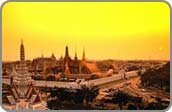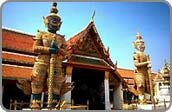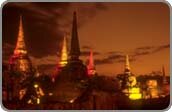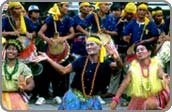|
 The hub of the business world in Thailand, Bangkok is one of the most pleasantcities in the world, due to its friendly people. Thecapital of Thailand, its charm stems from the social climate and the tolerance to other cultures that so typically, characterizes the entire country. The hub of the business world in Thailand, Bangkok is one of the most pleasantcities in the world, due to its friendly people. Thecapital of Thailand, its charm stems from the social climate and the tolerance to other cultures that so typically, characterizes the entire country.
Despite its traffic congestions, Bangkok is a good choice as a first stop over city, when arriving in Thailand. It is cheap while at the same time providing excellent standards. That goes for food as well as accommodation.
It is one of the safest capital cities of any Third World country, a trait, which is in line with the rest of the Thailand. Robbery is not a pressing problem if compared to most western capitals and even the streets are generally safe at night.
Entertainment is plentiful, and shopping a pleasure. There are many worthwhile Buddhist Temples to see and the Palace is a popular spot. The floating markets are a photographer's dream and one can take a boat trip up the Chao Phraya River that runs through the heart of the city. 
As to the weather Bangkok's temperature averages around the low to mid 30s almost year round. The heaviest rains fall in September and October but as with all of Thailand, the rain is hardly worth worrying about, as the sun is sure to poke its head out between refreshingly cool showers or spectacular thunderstorms. During the rainy season accommodation and package rates are often a lot less than at other times of the year.
 The Beginning of Bangkok The Beginning of Bangkok
Bangkoks history of the past 200 years is interwoven with the Chakri dynasty, which still reigns but no longer rules Thailand today. After Chao Phaya Chakri was crowned under the royal title of Rama I in 1782, one of his first major decisions concerned his capital. It is often said that Rama I founded Bangkok as his capital while before the capital had been Thonburi. However, in this abbreviated form, history is summarized not very accurately.
First of all, Bangkok was not really founded by Rama I. It had been a settled area for several hundred years already and it had even been well known to European merchants who commonly stopped over at Bangkok on their way to Ayuthaya.
Second, the sharp demarcation between Thonburi and Bangkok is not justified. While European merchants stuck to the name of Bangkok for their place of stopover, the community left and right of the Chao Phaya River was known to the Siamese as the town of Thonburi, having been elevated from the village status of Bangkok King Taksin chose Thonburi as his capital. While it is true that King Taksin had erected his palace and all major buildings on the right bank of the Chao Phaya River, the city of Thonburi settled areas on both banks.
King Taksins rationale had been to have the river flowing through the capital as he feared another Burmese attack after Ayuthaya had been leveled by Burmese armies in 1767; in the case of a new attack he wanted to have an easy escape option. This option was maintained by having the river flowing through, not just alongside the capital. His idea was that he could embark his people and troops then make a getaway on the Chao Phaya. The destination would have been his old stronghold of Chantaburi on the east coast, close to what is now Cambodia.
On the other hand, when Chao Phaya Chakri became King of Siam, the Burmese threat was no longer as eminent as before; Siam was again a strong power, on equal footing with the Burmese. Rama I, didnt think in terms of easy escape routes anymore, but in terms of strong defence. He had no intention of vacating his capital, should the Burmese march on it - he wanted to defend it by all means. For this purpose, a river flowing through the capital was a disadvantage as it would be difficult to secure. Therefore, he decided to neglect the western, larger side of what had been Thonburi, instead concentrating everything important on the eastern side. This of course included his own palace.
To make space for his palace where it is still located, a large settlement on the eastern side of Thonburi had to be razed. At the end of the 18th century, Chinese inhabitants had chiefly occupied the present palace area. Chao Phaya Chakri had the whole Chinese community transferred some three kilometers downstream, to an area then known as Sampheng. The Chinese still live in that area, and Sampheng Lane now is a famous Chinese shopping area.
Work on the Grand Palace and the Temple of the Emerald Buddha was by and large completed in 1785. The new capital, now more or less just covering the area on the eastern side of the Chao Phaya was inaugurated under the new name "Krung Thep Maha Nakhon Amorn Rattanakosindra Mahindrayutthaya Mahadilokpop Noparattana Radchhani Burirom Udom Rachnivet Mahastan Amorn Pimarn Avatarn Satit Sakatuttiya Vishnukarm Prasit.
" In English: "City of Angels, Great City and Residence of the Emerald Buddha, Impregnable City of God Indra, Grand Capital of the World, Endowed with Nine Precious Gems, Abounding in Enormous Royal Palaces which Resemble the Heavenly Abode where Reigns the Reincarnated God, a City given by Indra and Built by Vishnukarm". For convenience, it is the custom to abbreviate the name to Krung Thep. And for their further convenience, Westerners continue to call the place Bangkok.
 Chinese New Year, a time of firecrackers, lion dancers parading through the streets and time to spring-clean the house, is celebrated in February by all Chinese-Thais. Lanterns line the streets and the smell of incense wafts through the air. Dragon parades weave down roads and children gad about everywhere. Chinese New Year, a time of firecrackers, lion dancers parading through the streets and time to spring-clean the house, is celebrated in February by all Chinese-Thais. Lanterns line the streets and the smell of incense wafts through the air. Dragon parades weave down roads and children gad about everywhere.
Royal Ploughing Ceremony May An ancient Brahman ritual, conducted at Sanam Luang, Bangkok, in which farmers believe is able to forecast the abundance of the next rice crop. The event is a result of series of ceremonies that are conducted by Phraya Raek Na, portrayed by a high-ranking official from the Ministry of Agriculture and Cooperatives who wears colourful tradition costumes. This ceremony is considered the official commencement of the rice-growing season.
The most frenetic festival in the country is that of Songkran, the Luna New Year. Held from the 13th to 15th April each year&its a wet one! Traditionally it was celebrated by Buddha images being bathed with water and the showing of respect to monks and elders. From the sprinkling of water onto someones hands as a sign of respect it has evolved into mass drenching for anyone who decides to venture outdoors. This has to be one of the friendliest, though wet, festivals anywhere and a great way to make new friends.
TIP: Travellers be warned, dont leave cameras, computers or cell phones, unprotected¬hing is spared if you happen to get a dousing.
The 15th May is Buddhas Birthday. Local Wats (Buddhist Temples) celebrate by holding candlelit processions. A tourist may take part in these parades and it can prove great fun.
TIP: Lady visitors please note; a monk may not touch a woman so please show respect and keep your distance.
July, sees Thai Buddhists celebrating Buddhist lent or Asanha Puja, the full moon festival. Beginning mid to late in the month, this is the period when young men enter their monk hood for the rainy season and ordained monks remain in a single monastery for three months. One can view Buddhist temples throughout the year, but this tradition can be picturesque due to the activity of the saffron robed followers.
Its the Queens Birthday on August 12th and also Thailand s mothers day. As with all royal anniversaries this celebration guarantees a firework display.
One of the most beautiful and moving sights are the festivities relating to the annual festival of Loi Krathong held in November. This is when you cast away your troubles and call in the hopes of the future. As the moon rises in the evening a small lotus-shaped raft of banana leaves filled with flowers, a candle, a snip of your nail, a piece of your hair and a few coins, is set afloat in the ocean or down a waterway conjuring up good luck for the forthcoming year. In some areas large paper hot-air balloons are also released.
December 5 is the Kings Birthday. The King is much revered throughout Thailand, something that is probably unique in the world today. All Thais celebrate his birthday and government buildings, private homes, businesses and the palace are all illuminated specially for the occasion. In Phuket, they hold a regatta in his honor.
Trooping of the Colours December Their Majesties the King and Queen preside over this impressive annual event, held in the Royal Plaza near the equestrian statue of King Chulalongkorn. Dressed in colourful uniforms, amid much pomp and ceremony, members of the elite Royal Guards swear allegiance to the King and march past members of the Royal Family.
Official Holidays
January 1 - New Years Day
February (full moon day) - Makka Bucha
April 6 - Chakri Day
April 13 - Songkran, Thai New Year
May 1 - Labor Day
May 5 - Coronation Day
May 7 - Ploughing Ceremony
May (full moon day) - Visakha Bucha
July (full moon day) - Asanha Bucha commemorates the first sermon of Buddha
August 12 - Queens Birthday
October 23 - Chulalongkorn Day
December 5 - Kings Birthday
December 10 - Constitution Day
December 31 - New Years Eve
|
